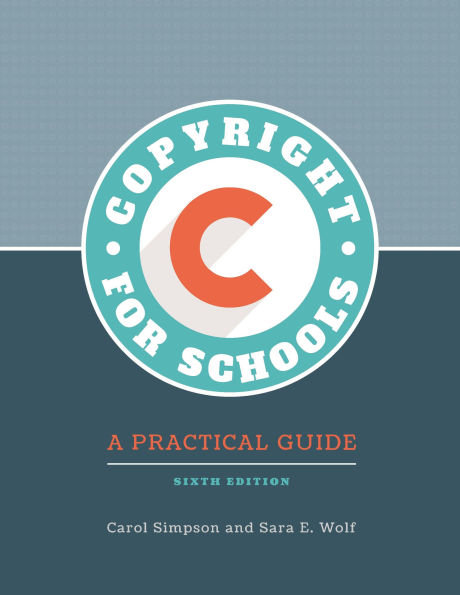Copyright for Schools: A Practical Guide
Copyright for Schools makes legal concepts related to U.S. copyright law understandable to educators. A staple on reference shelves, it has now been updated with new court rulings and technology applications.
This updated edition of Copyright for Schools explains U.S. copyright law as it applies to education settings clearly and concisely for teachers and school librarians.
Topics new to this edition include copyright implications related to the use of such streaming services as Netflix™ and Pandora™, links to online tools that teachers can use to assist them in making their own daily decisions regarding the use of copyrighted materials, and implications relating to the use of anonymous internet publishing tools such as Snapchat™ and use of Cloud-based sharing. Other new topics include issues related to disability, how to appropriately respond to cease and desist letters and other legal inquiries, implications of the Music Modernization Act, and expanded discussion of open resources such as Creative Commons licenses.
This edition also adds a concordance in a "Scope and Sequence" table format, so all information related to U.S. copyright knowledge is accessible no matter where it resides within the text, and provides links to online tools and resources that can be used to guide users of copyrighted materials in making decisions about how to use them. Still included are the real-world applications and the Q&A sidebars from prior editions.
1130196621
This updated edition of Copyright for Schools explains U.S. copyright law as it applies to education settings clearly and concisely for teachers and school librarians.
Topics new to this edition include copyright implications related to the use of such streaming services as Netflix™ and Pandora™, links to online tools that teachers can use to assist them in making their own daily decisions regarding the use of copyrighted materials, and implications relating to the use of anonymous internet publishing tools such as Snapchat™ and use of Cloud-based sharing. Other new topics include issues related to disability, how to appropriately respond to cease and desist letters and other legal inquiries, implications of the Music Modernization Act, and expanded discussion of open resources such as Creative Commons licenses.
This edition also adds a concordance in a "Scope and Sequence" table format, so all information related to U.S. copyright knowledge is accessible no matter where it resides within the text, and provides links to online tools and resources that can be used to guide users of copyrighted materials in making decisions about how to use them. Still included are the real-world applications and the Q&A sidebars from prior editions.
Copyright for Schools: A Practical Guide
Copyright for Schools makes legal concepts related to U.S. copyright law understandable to educators. A staple on reference shelves, it has now been updated with new court rulings and technology applications.
This updated edition of Copyright for Schools explains U.S. copyright law as it applies to education settings clearly and concisely for teachers and school librarians.
Topics new to this edition include copyright implications related to the use of such streaming services as Netflix™ and Pandora™, links to online tools that teachers can use to assist them in making their own daily decisions regarding the use of copyrighted materials, and implications relating to the use of anonymous internet publishing tools such as Snapchat™ and use of Cloud-based sharing. Other new topics include issues related to disability, how to appropriately respond to cease and desist letters and other legal inquiries, implications of the Music Modernization Act, and expanded discussion of open resources such as Creative Commons licenses.
This edition also adds a concordance in a "Scope and Sequence" table format, so all information related to U.S. copyright knowledge is accessible no matter where it resides within the text, and provides links to online tools and resources that can be used to guide users of copyrighted materials in making decisions about how to use them. Still included are the real-world applications and the Q&A sidebars from prior editions.
This updated edition of Copyright for Schools explains U.S. copyright law as it applies to education settings clearly and concisely for teachers and school librarians.
Topics new to this edition include copyright implications related to the use of such streaming services as Netflix™ and Pandora™, links to online tools that teachers can use to assist them in making their own daily decisions regarding the use of copyrighted materials, and implications relating to the use of anonymous internet publishing tools such as Snapchat™ and use of Cloud-based sharing. Other new topics include issues related to disability, how to appropriately respond to cease and desist letters and other legal inquiries, implications of the Music Modernization Act, and expanded discussion of open resources such as Creative Commons licenses.
This edition also adds a concordance in a "Scope and Sequence" table format, so all information related to U.S. copyright knowledge is accessible no matter where it resides within the text, and provides links to online tools and resources that can be used to guide users of copyrighted materials in making decisions about how to use them. Still included are the real-world applications and the Q&A sidebars from prior editions.
70.0
In Stock
5
1

Copyright for Schools: A Practical Guide
394
Copyright for Schools: A Practical Guide
394Paperback(6th Revised ed.)
$70.00
70.0
In Stock

Product Details
| ISBN-13: | 9781440864834 |
|---|---|
| Publisher: | Bloomsbury Academic |
| Publication date: | 01/12/2021 |
| Edition description: | 6th Revised ed. |
| Pages: | 394 |
| Product dimensions: | 8.55(w) x 10.95(h) x 0.95(d) |
About the Author
What People are Saying About This
From the B&N Reads Blog
